Labor Force Participation Elasticities of Women and Secondary Earners within Married Couples » książka
Labor Force Participation Elasticities of Women and Secondary Earners within Married Couples
ISBN-13: 9781507564912 / Angielski / Miękka / 2015 / 36 str.
Labor Force Participation Elasticities of Women and Secondary Earners within Married Couples
ISBN-13: 9781507564912 / Angielski / Miękka / 2015 / 36 str.
(netto: 56,02 VAT: 5%)
Najniższa cena z 30 dni: 55,53 zł
ok. 13-18 dni roboczych.
Darmowa dostawa!
Labor supply elasticities are often used to evaluate the effect of changes in tax rates on the total hours worked in the economy. Historically, married women have tended to have larger labor supply elasticities than their spouses because they were the secondary earners in a couple. However, those elasticities have fallen sharply in recent decades-a decline that has been attributed to greater labor force participation rates and increased career orientation among married women. Indeed, a growing share of wives earn more than their husbands, raising the question whether a person's sex or relative earnings is the relevant factor affecting the sensitivity of participation to wage and tax rates. In this book, we use administrative data to examine whether women or lower-earning spouses have larger labor supply elasticities. We present descriptive evidence on the share of women who are the primary earner and the frequency of transitions into and out of employment by sex and relative earnings. We find that lower earning spouses are more likely to start and stop working than women, except when a couple starts a family. We then model an individual's work decision using a dynamic probit model to isolate the labor supply response to changes in tax rates. We estimate that the participation elasticity with respect to the net-of-tax rate of the secondary earner-the spouse who typically has lower earnings-is about 0.03, slightly higher than that for women, though both of these overall elasticities are small. Participation elasticities with respect to income for both women and secondary earners are effectively zero. Our estimates are robust to several alternative models, including alternative specifications of secondary earner.











